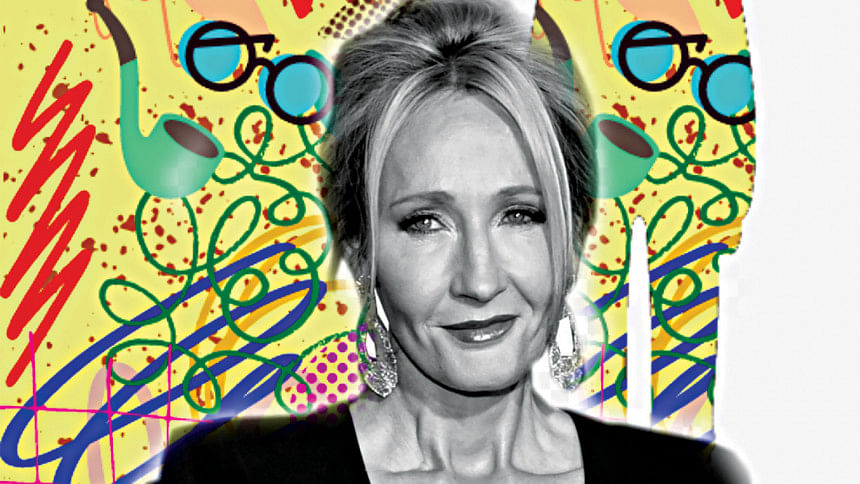Should we separate art from the artist?

When I was in 9th grade, a friend introduced me to the works of director Lars of von Trier, starting with the film Dogville (2003). I'd never seen a feature film play out so well, in such intensity, with nothing but a largely-empty sound stage for a film set. It was an experimental film of sorts, and I grew increasingly enamoured with the critically-acclaimed director's works from then on, until in 2017, Icelandic singer Bjork's statements accusing von Trier of sexual harassment shook me out of my years-long reverie. The first thought that popped into my head was this: How can such a horrible person create such nuanced art?
It took me another couple of years to realise that the ugliness always lurks in evil geniuses, alongside a shocking lack of sensitivity in their art. I had just never noticed it.
More recently, British author and philanthropist JK Rowling has come under fire on social media for what can only be described as a self-sabotaging campaign. She has been called out for being transphobic, Islamophobic, and classist. None of the accusations are unfounded.
In March 2019, Rowling issued statements confirming a potential romance between two of her most iconic characters, Albus Dumbledore and Gellert Grindelwald, which wasn't explored much in the Harry Potter series. Rowling's approach to this relationship seems to border on what's commonly known as "queer-baiting", a recently-popularised marketing tactic which only hints at LGBTQIA+ relationships instead of portraying them with depth. That Dumbledore's character might not be straight was always only alluded to in the Harry Potter books, but never depicted with nuance. Why explore the angle now—albeit still indirectly—when the Fantastic Beasts franchise is failing at the box office? How do we know it isn't a ploy to appear "woke" to attract more viewers?
Rowling's anti-LGBTQIA+ stance was made clearer when she ridiculed an article by North American media platform Devex for using the phrase "people who menstruate" instead of "women". Her mocking tweets refused to take into consideration the menstrual health of individuals who identify as genderqueer, transgender, transsexual, or non-binary, similar to the way that her most iconic books catered primarily to a straight, white, Christian audience. People of other religions, nationalities, ethnicities, and sexualities would only ever dot the periphery in her fiction.
Look no further than the characterisation of the Patil twins, Seamus Finnegan, and Cho Chang in the Harry Potter series, or the Jawanda family in The Casual Vacancy (2012). Look at the sole focus on Christmas, New Year's, and Halloween celebrations at Hogwarts. Consider the existence of house elves—their blatant oppression further worsened by how shockingly normalised the practice is throughout all the Potter books, as though mimicking the practices of 18th century British colonials who enslaved Native Americans, Africans, and Indians. Even more disturbing is the house elves' acceptance of the situation, Dobby being the only exception before he too is ultimately killed off. Whatever redemption Rowling might have achieved with Hermione Granger's SPEW (Society for the Protection of Elfish Welfare) campaign died when Hermione started being ridiculed by her peers because of it. The SPEW campaign ends up serving as nothing but comic relief, with Hermione made to seem like a crazed individual on a witch-hunt. Other examples of Rowling's xenophobia and racism can be found among the giants, centaurs, and goblins in the series—giants are unintelligent and destructive, centaurs harbour a near-hypnotic herd mentality reserved for attacking humans, and goblins are cunning and deceitful. Interactions with them almost always end in chaos. Meanwhile Hagrid, one of the main characters, is constantly treated with animosity by most witches and wizards due to his part-giant heritage.
Similar examples abound in Rowling's post-Harry Potter fiction. In September 2020, hot on the heels of further controversies surrounding transphobic comments and her new thriller, Troubled Blood (Sphere Books), Rowling was further accused of harbouring Islamophobic sentiments. The accusations stem all the way from her previously released novel The Silkworm (2014) written under the pseudonym Robert Galbraith, in which the narrative exploits negative stereotypes surrounding Muslim women. An excerpt from the novel reads, "Assuming somebody really did enter the house on the fourth, I've got to say a burqa's a bloody good way of getting in and out without being recognised. Can you think of another way of totally concealing your face and body that wouldn't make people challenge you?"
I've been a Rowling fan since I read Harry Potter and The Philosopher's Stone (1997) in 3rd grade. These troubling revelations about her mind set have been a devastating blow for me, a doting fan who'd once looked up to the British author as a hero and an icon. The Wizarding World had been an integral part of my childhood and it's suddenly become painful to hold onto, because the problematic signs that were always there are only now coming to my attention.
Yet it isn't really surprising that Rowling amassed such a dedicated fandom despite harbouring such troubling views. She is a white woman living in a predominantly white country, after all. In the 1990s, when the Harry Potter series first came out, it was a given that her works would put more emphasis on being relatable to a white audience. Social media platforms weren't as active at the time to help highlight coloured and minority voices. There were no trending hashtags. Orientalism reigned strong, meaning JK Rowling wasn't the first or the only writer to have gotten away with writing for a white audience.
Two use another popular example—crime thriller icon Agatha Christie has sold more than two billion copies of her famous novels around the world in more than 100 languages, adapted into around 30 feature films. The sheer volume of their reach indicates to what extent Christie's views would have shaped her readers' opinions, which were often xenophobic. In her book Death On The Nile (1937), white characters can be found commenting on Egyptian natives: "They're not educated, poor creatures", while the character Dr Bressner speaks of the Western world as the central world—a gunshot wound on another character cannot be treated until they can ".. get him to civilization", away from a cruise ship on the Nile.
This brings us back to the question posed in the title of this article, and my answer is, no. There's no such thing as separating the art from the artist, for the former is a product of the latter's thoughts. Artists draw inspiration from their own perspectives of the world and they leave a part of themselves in every piece that they create. Yet it has been argued that art can't be considered personal property, for while it is about self-expression, it is also an ideology born out of shared experiences by individuals from all walks of life. The essence of art is fluid, and it thrives on a network formed of multiple minds. Interpretation is subjective.
As the audience, it's up to us to spot the piece of the artist's soul hidden in the work and determine for ourselves if it means to convey empathy or hate. What we should be asking ourselves is whether or not we're willing to point out the flaws in the works of legends held in high esteem by both academics and popular culture, whether we are prepared to identify them as part of a grander and often problematic social construct.
As of September 14, 2020, the most trending Twitter hashtag related to JK Rowling was #RIPJKRowling, an example of the rampant "cancel culture" that tries to restrict people's agency on public platforms. Rowling was, culturally speaking, beheaded following her recently released Troubled Blood novel in which she characterises a serial killer as a cross-dresser. Readers have equated it with previous characters in fiction such as Jame Gumb/ Buffalo Bill in Silence of the Lambs (St. Martin's Press, 1988), Norman Bates in Psycho (Simon & Schuster, 1959), and Dr. Robert Elliott in the film Dressed to Kill (1980). To what extent we get to challenge artists' problematic views with hate speech and violent death threats (the latter being never acceptable) is a whole other opinion piece.
But the fact remains that an author can always portray the world as it is in their work, populated by flawed individuals. That kind of realistic portrayal is welcome and necessary, because we need to see, understand, and get under the skin of all that's beautiful, horrible, and all the shades in between. But a fine line exists within that representation. Flaws cannot be glorified, only explored. That's where we, the consumers of art, need to discern the boundaries.
And how can we do this?
Remember Lars von Trier, the disgraced filmmaker I was talking about earlier? Almost all his films feature graphic depiction of women being treated brutally. Critics today have commented on his latest serial killer flick, The House That Jack Built (2018), calling it out as a gruesome comeback of sorts against the sexual harassment charges placed on him.
To take a more popular example—American author H P Lovecraft is posthumously regarded as the "father of modern horror", with his works having inspired an entire subgenre known as "Lovecraftian horror"; but that doesn't erase his history of being a raging bigot, a white supremacist, and an anti-Semite. These views are prominent in poems like "On The Creation of N***ers", in which he addresses Black people as "semi-human" and "filled with vice". Nearly a century after Lovecraft's death, however, another American author, Matt Ruff, paid a homage to the icon through his novel Lovecraft Country (2016) in he places Lovecraft's creations at the epicentre of a horrifyingly racist America in the 1950s, as witnessed by the Black protagonist Atticus Freeman and his oppressed family and friends. What Ruff did was take the "Lovecraftian horror" genre apart, and completely reinvent it from a feminist perspective as part of his personal interpretation of Lovecraft's works. Lovecraft himself would've been scandalised.
I could write a whole thesis on how Rowling, von Trier, Lovecraft, and Christie are all cut from the same cloth. But we're not really here to discuss their personalities, but how that has affected their works and where we should put our foot down when it comes to consuming them. Art is but an extension of the artist, so do we just leave it at that? We do not. We question the art, and subsequently, the artist behind it. We do not excuse their questionable opinions.
Rasha Jameel studies microbiology while pursuing her passion for writing. Reach her at [email protected].

 For all latest news, follow The Daily Star's Google News channel.
For all latest news, follow The Daily Star's Google News channel. 



Comments